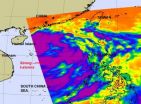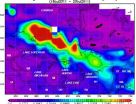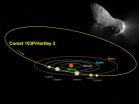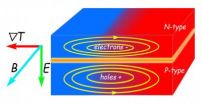(Press-News.org) The strongest thunderstorms that make up tropical storm Muifa are on the storm's eastern and southern sides, according to infrared imagery from NASA's Aqua satellite. The northern side is being weakened by a nearby weather system.
Tropical Storm Muifa is moving through the western North Pacific Ocean, and had strengthened during the early morning hours of July 28. On July 27, it was tropical depression 11W and winds have since increased to 40 knots (46 mph/74 kmh).
When NASA's Aqua satellite passed over Tropical Storm Muifa the Atmospheric Infrared Sounder (AIRS) instrument captured an infrared look at the storm's cold cloud tops and strong thunderstorms. The colder the cloud tops, the higher the thunderstorms and the stronger they are. The AIRS infrared image on July 27 at 1647 UTC (12:47 p.m. EDT) showed that the highest, coldest thunderstorms were on the eastern and southern sides of the center.
So why doesn't the northern side of Tropical Storm Muifa have any strong convection (rapidly rising air that form thunderstorms that make up the storm)? The answer is that Muifa is located 10 degrees southeast of a high pressure area in the western North Pacific Ocean that is preventing evaporation in the storm's northern quadrant. The high pressure area is pushing air downward toward the surface and preventing evaporation and formation of thunderstorms.
At 1200 UTC (8 a.m. EDT) on July 28, 2011, Muifa was located 655 nautical miles west of Andersen Air Force Base, Guam, near 12.4 North and 133.6 East. It was moving to the west-northwest near 12 knots (14 mph/22 kmh) and is expected to continue in that direction and turn more toward the north in the next couple of days.
INFORMATION:
NASA identifies the areas of Tropical Storm Muifa's strength
2011-08-01
ELSE PRESS RELEASES FROM THIS DATE:
NASA eyes Tropical Storm Nock-Ten's heavy rains for Hainan Island and Vietnam
2011-08-01
Infrared satellite imagery from NASA's Aqua satellite shows bands of strong thunderstorms wrapping around the center of Tropical Storm Nock-Ten as it makes its way through the South China Sea and two landfalls on Hainan Island and in Vietnam.
Bands of strong thunderstorms that make up tropical storm Nock-ten were visible in an infrared image captured on July 28 by the Atmospheric Infrared Sounder (AIRS) instrument that flies on NASA's Aqua satellite. The colder the cloud tops, the higher the thunderstorms and the stronger they are, and cloud top temperatures over a large ...
NASA measures wildfire pollution pour over Niagara Falls
2011-08-01
Water isn't the only thing pouring over Niagara Falls. Pollution from fires in Ontario, Canada is also making the one thousand mile trip, while being measured by NASA's Aqua satellite.
One instrument that flies aboard two of NASA's satellites has provided two views of the pollution from the fires in Ontario. The Moderate Resolution Imaging Spectroradiometer, or MODIS instrument, flies onboard NASA's Aqua and Terra satellites. MODIS has provided a visible look at the smoke and pollution that has spread over Niagara Falls and east to Nova Scotia.
As of July 20, the Canadian ...
Cash Advances US Provides Fast Cash Loans Online With No Credit Check
2011-08-01
Less-than-perfect credit score can wipe off any opportunity to get some cash you need at the moment as most of the lenders consider people with bad credit history as high-risk borrowers. However, Cash Advances US offers particular cash loans with no credit check which are available online. The service was actually designed specially for consumers with damaged credit report who often face troubles applying for some extra money.
It's fast and simple to take out online payday advance loans performed by the company as the application process is held totally on the Internet. ...
Using a 'systems biology' approach to look under the hood of an aggressive form of breast cancer
2011-08-01
SEATTLE – Using a "systems biology" approach – which focuses on understanding the complex relationships between biological systems – to look under the hood of an aggressive form of breast cancer, researchers for the first time have identified a set of proteins in the blood that change in abundance long before the cancer is clinically detectable. The findings, by co-authors Christopher Kemp, Ph.D., and Samir Hanash, M.D., Ph.D., members of Fred Hutchinson Cancer Research Center's Human Biology and Public Health Sciences divisions, respectively, are published online ahead ...
SOHO watches a comet fading away
2011-08-01
On Nov. 4, 2010, NASA's EPOXI spacecraft came within 450 miles of Comet Hartley 2, a small comet not even a mile in diameter, which takes about six and a half years to orbit the sun. Designated officially as 103P/Hartley 2, the comet thus became the fifth for which scientists have collected close-up images.
But the comet was also observed from another spacecraft: the Solar and Heliospheric Observer (SOHO), better known for its observations of the sun. Together, the two returned data about what appears to be an irregular comet, belching chunks of ice and losing water at ...
Fresh Produce Clothing's Summer-Fall Collections Feature Unique Pieces of Wearable Works of Art
2011-08-01
Fresh Produce customers can make an artful statement when they wear the eclectic prints featured in its latest collections of effortless and spirited looks. The inspired prints are available in a variety of new styles and fabrications from cool cotton voile to comfy cotton jersey and versatile rayon-lycra.
This summer's standout print is the Blue Tahitian Flower. Fresh Produce women adore this romantic watercolor-inspired motif. Its look and feel is "pure summer" with beautiful tropical flowers captured in soft, watery hues and translated to new chic tunics, ...
An unexpected clue to thermopower efficiency
2011-08-01
Scientists at the U.S. Department of Energy's Lawrence Berkeley National Laboratory (Berkeley Lab) and their colleagues have discovered a new relation among electric and magnetic fields and differences in temperature, which may lead to more efficient thermoelectric devices that convert heat into electricity or electricity into heat.
"In the search for new sources of energy, thermopower – the ability to convert temperature differences directly into electricity without wasteful intervening steps – is tremendously promising," says Junqiao Wu of Berkeley Lab's Materials ...
Boloco Earns Another 'Green' Star
2011-08-01
Back in March 2008 boloco, a chain of inspired burrito restaurants, became the first fast-casual chain in New England to become a Certified Green Restaurant by the Green Restaurant Association (GRA). But when boloco found out an even higher level of certification could be achieved - well, let's just say they reached for the stars. Boloco is now the first chain* of restaurants to become a 2 Star Certified Green Restaurant across all of their 17 locations.
For each of boloco's 17 locations to earn the GRA's rigorous two-star certification, they had to be inspected and ...
New study outlines economic and environmental benefits to reducing nitrogen pollution
2011-08-01
New, York, NY—July 28, 2011—A new study co-authored by Columbia Engineering professor Kartik Chandran and recently published in the journal, Environmental Science & Technology, shows that reducing nitrogen pollution generated by wastewater treatment plants can come with "sizable" economic benefits, as well as the expected benefits for the environment.
Chandran was one of five scientists from around the U.S. who worked on the study, along with James Wang of NOAA's Air Resources Laboratory and formerly of Environmental Defense Fund (EDF); Steve Hamburg, Chief Scientist ...
Genetic evidence clears Ben Franklin
2011-08-01
HOUSTON -- (July 28, 2011) -- The DNA evidence is in, and Ben Franklin didn't do it.
Genetic tests on more than 1,000 Chinese tallow trees from the United States and China show the famed U.S. statesman did not import the tallow trees that are overrunning thousands of acres of U.S. coastal prairie from Florida to East Texas.
"It's widely known that Franklin introduced tallow trees to the U.S. in the late 1700s," said Rice University biologist Evan Siemann, co-author the new study in this month's American Journal of Botany. "Franklin was living in London, and he had tallow ...







